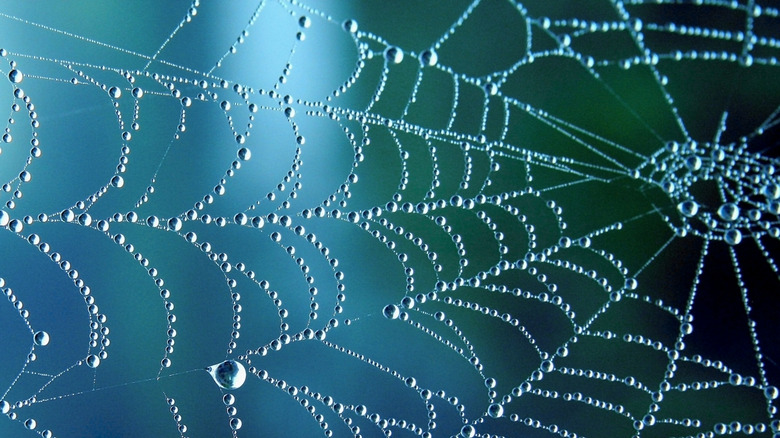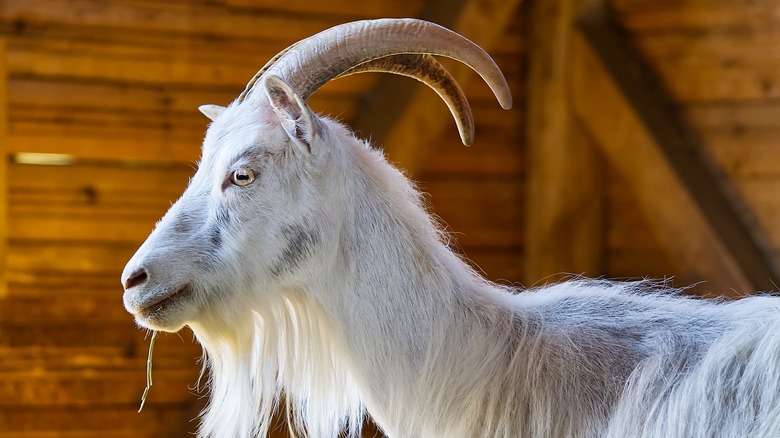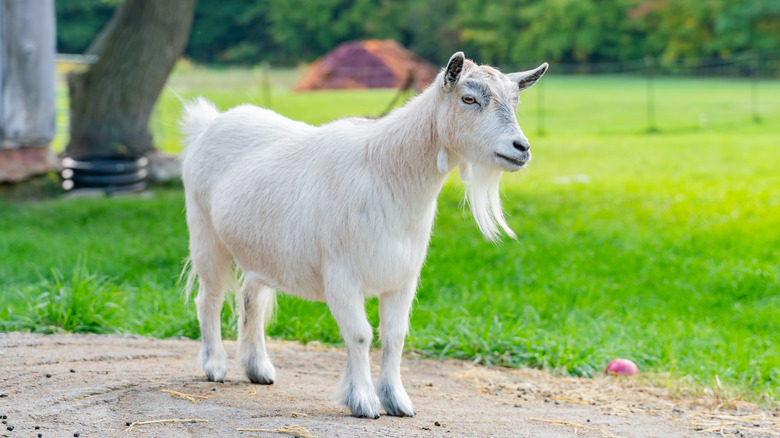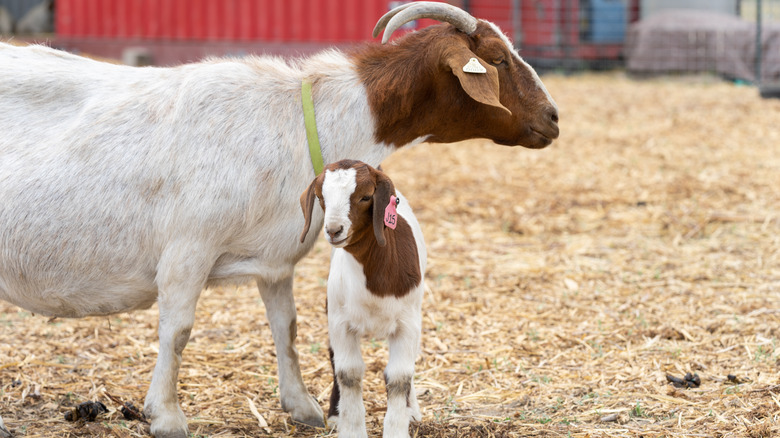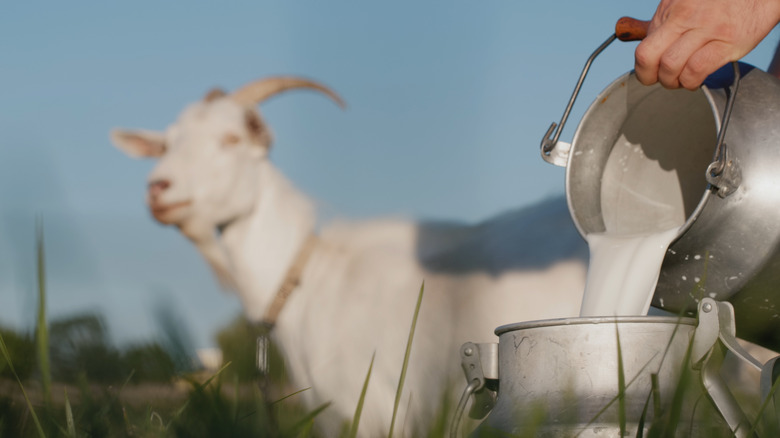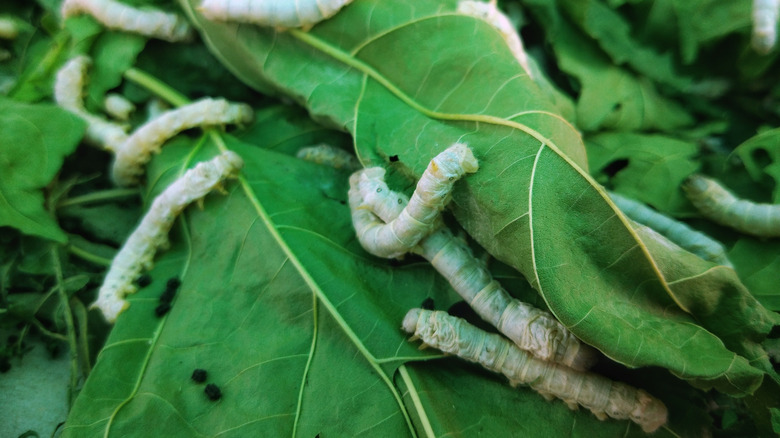Why Scientists Are Crossing Goats With Spider Genes
Spider silk is incredibly strong. While it's not technically stronger than steel, as some like to claim, it does equal or surpass it for certain measures of strength, as Michelle Oyen wrote in The Conversation. Tensile strength measures how much weight a material can bear without breaking, and steel has a tensile strength that ranges between 0.2 and almost 2 GPa. One variety of spider silk has a tensile strength right in the middle, slightly more than 1 GPa. Spider silk also has a density nearly six times less than that of steel, meaning its strength-to-density ratio is greater. If a strand of spider silk and a steel bar had the same diameter, the spider silk strand would be five times stronger, according to the University of Bristol School of Chemistry. A pencil-width strand of spider silk could theoretically stop a Boeing 747.
Its strength makes spider silk an incredibly attractive material for engineers and designers. Potential uses range from bullet-proof textiles to car airbags to several medial uses like jaw repair, eye sutures, and artificial tendons and ligaments, according to Phys.org. However, none of these have been able to get past the idea stage because it's too hard to grow enough silk. Growing it would require lots and lots of spiders spinning, but spiders don't play well together. When scientists attempted to set up spider farms, the spiders ate each other. So instead, researchers turned to goats.
Silky milk
To get spider silk in larger amounts from a less cannibalistic source, scientists have experimented with genetically modifying goats to produce the spider silk protein in their milk, according to Phys.org. The first to attempt this was the Montreal-based company Nexia Biotechnologies (per AFN). In January 2000, the company bred two male goats that had been modified with spider genes, New Scientist reported. 'What we're doing here is ingeniously simple,” Nexia president and CEO Jeffrey D. Turner told The New York Times two years later. ”We take a single gene from a golden orb-weaving spider and put it into a goat egg. The idea is to make the goat secrete spider silk into its milk.”
Why goats? Because both spiders' silk glands and goats' mammary glands contain cells that make similar types of complex proteins that can be dissolved in water, according to New Scientist. Turner hoped that the spider-silk proteins would turn up in the milk of the genetically-modified goats. The company then planned to use the milked proteins in order to mass-produce spider silk.
Don't worry; be happy
By 2002, the two male goats had been bred with females to produce female offspring that also contained the spider-silk protein in their genes, and the female offspring were about to give birth themselves, as New Scientist reported at the time. The genetically modified goats were raised in a converted maple syrup farm in Quebec, Canada, according to The New York Times. The farm had goat breeds from all over the world, and their caretakers made every effort to ensure their comfort, even piping music from their country of origin into their homes, Wired reported. "Some of them had reggae music, and other ones had rhythm and blues," Ali Alwattari, a materials scientist who worked with the goats at the time, recalled to Wired. "Relaxation of the goats was very important."
Nexia succeeded in spinning the first mile of human-made spider silk around 2003. However, the silk proteins produced by the goats were too small and weak to hold up commercially. Nexia went bankrupt in 2009. Two of the spider-fied goats, Sugar and Spice, ended up on display at the Canada Agriculture Museum in Ottawa until they were removed from public view in 2013 following protests, according to AFN.
Spider goats on the range
Nexia's bankruptcy was not the end for the modified goats, however. Molecular biologists Justin Jones and Randy Lewis traveled to Canada from Wyoming and brought around 20 of the goats back to their lab with them in a trailer, according to Wired. Lewis was at the University of Wyoming when he first acquired the goats and then moved to Utah State University (with his goats) in 2011, according to his LinkedIn profile.
Lewis worked with the so-called "spider goats" at a university farm in Logan, Utah, The Guardian reported in 2012. He was still working with them as of 2019, according to AFN. Based on his experience, Lewis said the genetic modification does not seem to hurt the goats. The spider gene is only made when the goats produce milk and is only present in their udders. "In over 15 years of breeding these goats, we have no indications of any abnormal health risks," he told AFN.
Milking the spider goats
How exactly do you go from modifying a goat's genes to producing spider silk? First of all, the goats have to be bred, and not all of them will be born with the gene, Phys.org explained. For example, when seven goat kids were born to Randy Lewis's team in February 2010, only three of them had the silk gene. Once the goats are old enough to lactate, researchers will milk them and then separate the protein from the milk, collecting it into "much, much higher quantities," Lewis told Phys.org.
The initial process of milking spider goats is basically the same as milking regular goats, Lewis told BBC News, and the milk itself looks just like normal goats' milk. "If you actually do an analysis of it, and you look at all the components of the milk, the only thing you'll find that's different is that there's one extra protein in there," he said. The researchers then bring the milk to the lab and process it until only the spider silk proteins remain, The Guardian explained. Scientists then use a glass rod to isolate individual fibers of the silk and spin them on a reel.
The future of silk
Randy Lewis told AFN in 2019 that there were many potential applications for his goat-milked silk. He said that the first commercial uses would probably be for fibers, gels, coatings, and adhesives. He also received a grant from the U.S. Navy in 2018 to develop an underwater spider web that could be used to tangle the propellers of enemy boats.
However, like Nexia, Lewis and his team are finding that goats might not be the best replacement silk spinners after all. His team has also worked on producing spider silk from genetically modified bacteria, alfalfa, and silk worms. In 2019, he co-wrote a paper published in Biomacromolecules explaining how they had used CRISPR/Cas9 technology to insert spider silk genes into the Bombyx mori silkworm. CRISPR/Cas9, which stands for "Clustered regularly interspaced short palindromic repeats and CRISPR-associated protein-9 nuclease," makes it possible to edit genes, a Utah State University press release explained. This technology should make it easier to mass-produce spider silk without spiders. "Prior to using CRISPR, our attempts to insert spider protein DNA into transgenic hosts were somewhat random," Lewis said in the press release.
